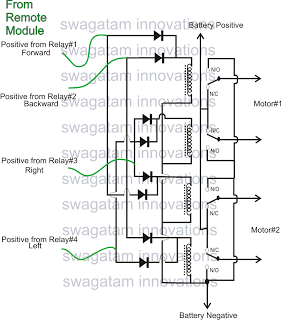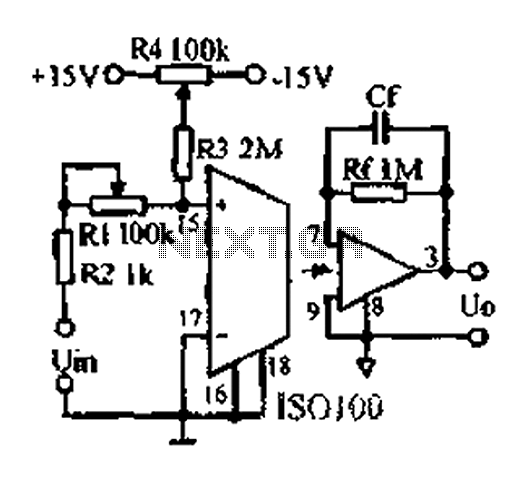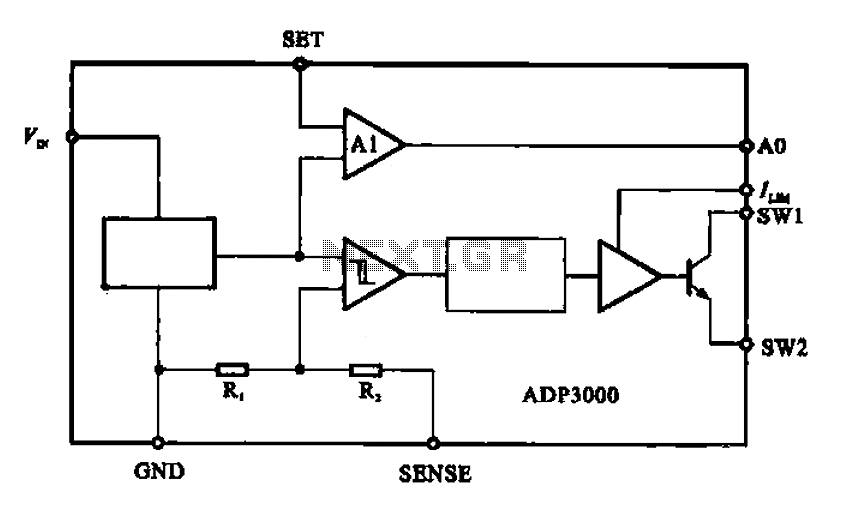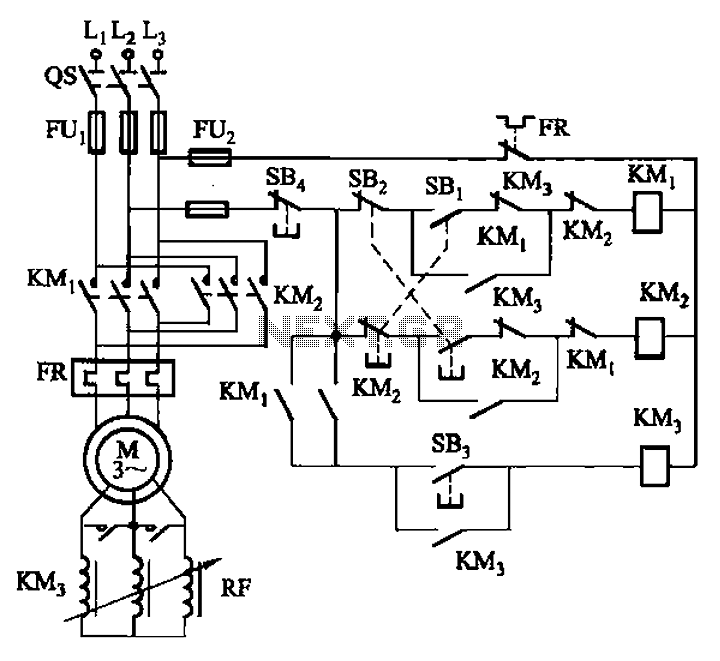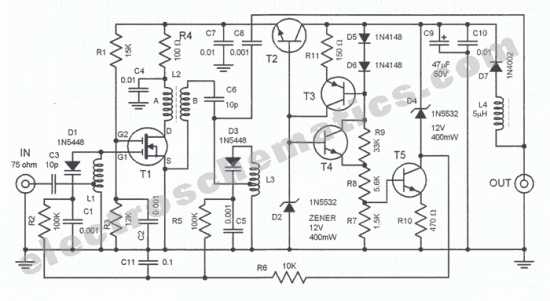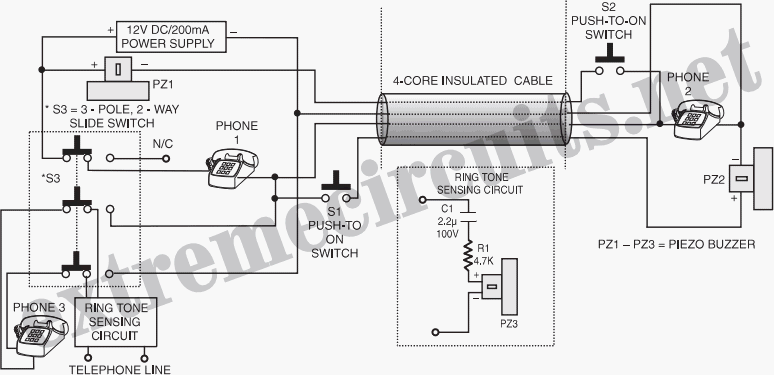
surround sound processor circuit
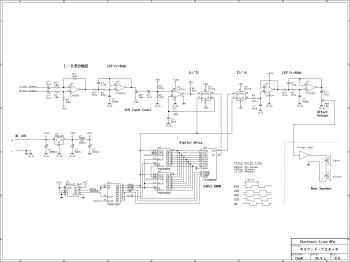
This is an easy-to-build surround sound processor circuit utilizing the digital delay processing method. This audio processor does not employ any specialized function integrated circuits that are difficult to obtain, and it is designed using only common-purpose integrated circuits. This surround processor generates a surround effect by processing two channels of stereo input. Most of these processors create a surround impact by separating reverberations from the input signal and applying various processes before mixing them into the front channels or outputting them as rear channels. The distinction between each channel is achieved using a differential amplifier from the operational amplifier. Higher frequencies in the differential signal are attenuated using a low-pass filter. These components are composed of common-purpose integrated circuits. The analog-to-digital converter is essentially a delta modulator that utilizes a comparator and a D-type flip-flop to convert the analog signal into digital data at a rate of one bit, 2 Msa/sec. After passing through the digital delay, the bit stream is directly converted back into an analog signal using an integrator. For the digital delay process, a DRAM chip is used as FIFO memory. This circuit design requires a 64K bit DRAM, but a 256K bit DRAM can be used instead. A shift register generates the Read-Modify-Write cycle, reading old data and storing new data in a single cycle. The lower byte of the address counter is assigned as the row address for the DRAM, which increments the row address with each cycle, allowing the refresh cycle to be omitted. The FIFO length is 65536 bits, and at 2 Msa/sec, it provides a delay time of 33 milliseconds. The PCB can be created in simple steps. Create the PCB design using PCB design software like Eagle, print the design on photo paper or glossy paper with a laser printer, and adhere the printed design to the copper side of the PCB. Heat it using a hot iron plate to transfer the ink to the PCB, making it ready for the etching process. If a laser printer is unavailable, the design can be printed on standard paper and copied onto glossy paper at a local copy service.
The surround sound processor circuit described utilizes a straightforward approach to achieve a surround effect from stereo audio input. The core of the design relies on common-purpose integrated circuits, making it accessible and easy to replicate. The digital delay processing method is central to its operation, enabling the separation of reverberations and the creation of a spatial audio experience.
The use of a differential amplifier allows for effective separation of the audio channels, enhancing the surround effect. The low-pass filter plays a crucial role in attenuating high-frequency components, ensuring that the output signal maintains clarity and fidelity. The delta modulator serves as the analog-to-digital converter, converting the incoming analog signals into a digital format suitable for processing. The choice of a DRAM chip as FIFO memory is significant, as it allows for efficient storage and retrieval of audio data, contributing to the overall performance of the processor.
The Read-Modify-Write cycle facilitated by the shift register is an essential feature, enabling real-time processing of audio data. The ability to increment the row address without the need for a refresh cycle simplifies the design and enhances reliability. The specified delay time of 33 milliseconds provides a suitable temporal spacing for creating an immersive surround sound experience.
For the PCB fabrication, the outlined process is practical and can be executed with minimal resources. The use of readily available materials and tools, such as PCB design software and a laser printer, makes this project accessible to hobbyists and professionals alike. The detailed steps for creating the PCB ensure that users can replicate the design accurately, leading to successful implementation of the surround sound processor circuit.This is the easy build surround sound processor circuit using the digital delay process method. This audio processor isn`t applying any unique function ICs that tough to obtain parsonaly, and designed in only common purpose ICs. The kind of this Surround Processor is producing the surround impact with processing two channels of stereo supply.
The majority of those are generates the surround impact with separates reverberations from supply signal and applies any processes, after which mix it to front channels or output as rear channel. The distinction in between each channels is separated with distinction amplifier from the op-amp. And greater frequencies inside the distinction signal are cut using the LPF. These are composed with common purpose ICs. The A-D converter is basically delta modurator that making use of a comparator plus a D type flip-flop.
And it converts analog signal into digital data of one bit, 2 Msa/sec. Following passed digital delay, the bit stream is directly conversion into analog signal using the integrater. For the digital delay method, a DRAM chip is utilised as a FIFO memory. This circuit design demands a 64K bit DRAM, but I utilized a 256K bit DRAM discovered within the junk box.
Shift register generates Read-Modify-Write cycle, read out old data and save new data in a single cycle. And lower byte in the address counter is assined as row address with the DRAM to increment row address every single cycle, to ensure that refresh cycle is often omitted.
The FIFO length is 65536 bits and 2 Msa/sec makes 33 msec of delay time. Make a PCB in very easy steps. ! Create your PCB design using PCB designer software like Eagle, print out your design on photo paper or glossy paper with laserjet printer. Stick the printed design on the PCB (copper side) and then heat it using hot iron plate. The ink will stick on the PCB and it will be ready for etching process. Note: If you don`t have laserjet printer, then you can print the design on standard paper. Copy the printed design at Copy Service around your location (with glossy paper). 🔗 External reference
The surround sound processor circuit described utilizes a straightforward approach to achieve a surround effect from stereo audio input. The core of the design relies on common-purpose integrated circuits, making it accessible and easy to replicate. The digital delay processing method is central to its operation, enabling the separation of reverberations and the creation of a spatial audio experience.
The use of a differential amplifier allows for effective separation of the audio channels, enhancing the surround effect. The low-pass filter plays a crucial role in attenuating high-frequency components, ensuring that the output signal maintains clarity and fidelity. The delta modulator serves as the analog-to-digital converter, converting the incoming analog signals into a digital format suitable for processing. The choice of a DRAM chip as FIFO memory is significant, as it allows for efficient storage and retrieval of audio data, contributing to the overall performance of the processor.
The Read-Modify-Write cycle facilitated by the shift register is an essential feature, enabling real-time processing of audio data. The ability to increment the row address without the need for a refresh cycle simplifies the design and enhances reliability. The specified delay time of 33 milliseconds provides a suitable temporal spacing for creating an immersive surround sound experience.
For the PCB fabrication, the outlined process is practical and can be executed with minimal resources. The use of readily available materials and tools, such as PCB design software and a laser printer, makes this project accessible to hobbyists and professionals alike. The detailed steps for creating the PCB ensure that users can replicate the design accurately, leading to successful implementation of the surround sound processor circuit.This is the easy build surround sound processor circuit using the digital delay process method. This audio processor isn`t applying any unique function ICs that tough to obtain parsonaly, and designed in only common purpose ICs. The kind of this Surround Processor is producing the surround impact with processing two channels of stereo supply.
The majority of those are generates the surround impact with separates reverberations from supply signal and applies any processes, after which mix it to front channels or output as rear channel. The distinction in between each channels is separated with distinction amplifier from the op-amp. And greater frequencies inside the distinction signal are cut using the LPF. These are composed with common purpose ICs. The A-D converter is basically delta modurator that making use of a comparator plus a D type flip-flop.
And it converts analog signal into digital data of one bit, 2 Msa/sec. Following passed digital delay, the bit stream is directly conversion into analog signal using the integrater. For the digital delay method, a DRAM chip is utilised as a FIFO memory. This circuit design demands a 64K bit DRAM, but I utilized a 256K bit DRAM discovered within the junk box.
Shift register generates Read-Modify-Write cycle, read out old data and save new data in a single cycle. And lower byte in the address counter is assined as row address with the DRAM to increment row address every single cycle, to ensure that refresh cycle is often omitted.
The FIFO length is 65536 bits and 2 Msa/sec makes 33 msec of delay time. Make a PCB in very easy steps. ! Create your PCB design using PCB designer software like Eagle, print out your design on photo paper or glossy paper with laserjet printer. Stick the printed design on the PCB (copper side) and then heat it using hot iron plate. The ink will stick on the PCB and it will be ready for etching process. Note: If you don`t have laserjet printer, then you can print the design on standard paper. Copy the printed design at Copy Service around your location (with glossy paper). 🔗 External reference
Warning: include(partials/cookie-banner.php): Failed to open stream: Permission denied in /var/www/html/nextgr/view-circuit.php on line 713
Warning: include(): Failed opening 'partials/cookie-banner.php' for inclusion (include_path='.:/usr/share/php') in /var/www/html/nextgr/view-circuit.php on line 713
